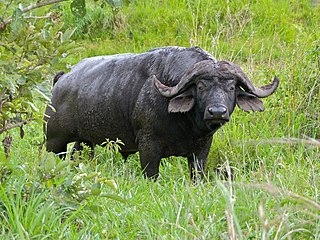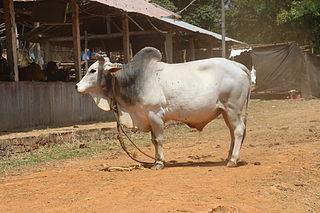
The Canchim is a breed of beef cattle developed in Central Brazil by crossing European Charolais cattle with Indubrazil cattle already kept in Brazil where Asian Zebu type cattle are best suited to the tropical conditions. When compared with Zebu bulls, Canchim bulls produce the same number of calves, but heavier and of superior quality. Compared to European breeds, the Canchim bull produces calves with the same weight but in larger numbers. The fast-growing progeny, from crossbred zebu cows with Canchim bulls, can be slaughtered at 18 months old from feedlots after weaning, up to 24 months old from feedlots after grazing and at 30 months from grazing on the range.

A zebu, sometimes known as indicine cattle or humped cattle, is a species or subspecies of domestic cattle originating in South Asia. Zebu are characterised by a fatty hump on their shoulders, a large dewlap, and sometimes drooping ears. They are well adapted to withstanding high temperatures, and are farmed throughout the tropical countries, both as pure zebu and as hybrids with taurine cattle, the other main type of domestic cattle. Zebu are used as draught and riding animals, dairy cattle, and beef cattle, as well as for byproducts such as hides and dung for fuel and manure. Zebu, namely miniature zebu, are kept as companion animals. In 1999, researchers at Texas A&M University successfully cloned a zebu.

The biological subfamily Bovinae includes a diverse group of 10 genera of medium to large-sized ungulates, including domestic cattle, bison, African buffalo, the water buffalo, the yak, and the four-horned and spiral-horned antelopes. The evolutionary relationship between the members of the group is still debated, and their classification into loose tribes rather than formal subgroups reflects this uncertainty. General characteristics include cloven hooves and usually at least one of the sexes of a species having true horns. The largest extant bovine is the gaur.

A brigantine is a two-masted sailing vessel with a fully square rigged foremast and at least two sails on the main mast: a square topsail and a gaff sail mainsail. The main mast is the second and taller of the two masts.

A tall ship is a large, traditionally-rigged sailing vessel. Popular modern tall ship rigs include topsail schooners, brigantines, brigs and barques. "Tall ship" can also be defined more specifically by an organization, such as for a race or festival.

The Nguni cattle breed is special to Southern Africa. A hybrid of different Indian and later European cattle breeds, they were introduced by Bantu-speaking tribes to Southern Africa during their migration from the North of the continent. The cattle breed is medium-sized and adapted to grazing on the highveld.

Cervelat, also cervelas, servelat or zervelat, is a sausage produced in Switzerland, France and parts of Germany. The recipe and preparation of the sausage vary regionally.

Nelore or Nellore cattle originated from Ongole Cattle cattle originally brought to Brazil from India. They are named after the district of Nellore in Andhra Pradesh state in India. The Nelore has a distinct large hump over the top of the shoulder and neck. They have long legs which help them to walk in water and when grazing. The Nelore can adapt to all except very cold climates. They are very resistant to high temperatures and have natural resistance to various parasites and diseases. Brazil is the largest breeder of Nelore. Nelore have the shortest ears of most Bos indicus types. There is a naturally polled strain of the breed.
Cebu is an island province of the Philippines.

Red Sindhi cattle are the most popular of all Zebu dairy breeds. The breed originated in the Sindh province of Pakistan, they are widely kept for milk production across Pakistan, India, Bangladesh, Sri Lanka, and other countries. It originated in Hyderabad(Pakistan) and Bikaner(India). They have been used for crossbreeding with temperate (European) origin dairy breeds in many countries to combine their tropical adaptations with the higher milk production found in temperate regions. It has been crossed with Jerseys in many places, including India, the United States, Australia, Sri Lanka, etc.
The Abyssinian Shorthorned Zebu is a breed of cattle found in Ethiopia.

Sahiwal is a breed of Zebu cattle which primarily is used in dairy production. The name Sahiwal originates from the Sahiwal district of Punjab province in Pakistan and is found in Sahiwal in Pakistan, Ferozpur,Amritsar and Sri Ganganagar(Rajasthan) in India. They produce the most milk of all zebu breeds, followed by the very similar Red Sindhi and Butana breeds.

Sanga cattle is the collective name for indigenous cattle of sub-Saharan Africa. They are sometimes identified as a subspecies with the scientific name Bos taurus africanus. These cattle originated in East Africa, probably the western shores of Lake Victoria, and have spread up the river Nile, with depictions on Ancient Egyptian murals. Sanga are an intermediate type, probably formed by hybridizing the indigenous humpless cattle with Zebu cattle. However, archaeological evidence indicates this cattle type was domesticated independently in Africa, and bloodlines of taurine and zebu cattle were introduced only within the last few hundred years. Although the timeline for their history is the subject of extensive debate, some authors date the first Sanga cattle to 1600 BC. They are distinguished by having small cervicothoracic humps instead of the high thoracic humps which characterize the Zebu.
Jamaica Hope is a dairy breed of cattle originating from Hope Farm in Jamaica. The breeding started in 1910, and was an attempt to develop an animal that was adjusted to the climate of the island. It is a lot of heat tolerant, has high resistance to ticks and tick-borne diseases, and can produce much milk even in the poor pasture land typical of tropical climates. The breed consists of approximately 80% Jersey, 15% Zebu and 5% Holstein. The whole process was to a great degree the work of Dr. Thomas Lecky, a pioneer in Jamaican agricultural science. Jamaica Hope today make out about 50% of the cattle on the island. A mature cow weighs about 500 kg, while a male weighs between 700 and 800 kg. A cow can produce 2,500 kg of milk per lactation period, which lasts for about 305 days. The butter fat content of the milk is around five percent.

The Malvi or Malavi, also known as Manthani or Mahadeopuri, is breed of zebu cattle from the Malwa plateau in western Madhya Pradesh, in central India. It is a good draught breed; the milk yield of the cows is low.

Taurine cattle, also called European cattle, are a subspecies of domesticated cattle originating in the Near East. Both taurine cattle and indicine cattle (zebus) are descended from the aurochs. Taurine cattle were originally considered a distinct species, but are now typically grouped with zebus and aurochs into one species, Bos taurus. Most modern breeds of cattle are taurine cattle.
Siri are a breed of cattle originating from Bhutan and are of the Zebu family of cattle. They are now in various parts of Sikkim and Darjeeling.

Hariana is an Indian Cow breed native to North India, specially in the state of Haryana. They produce about 5 liters of milk a day, compared to 8.9 liters when cross bred with Holstein Friesian cattle (HS), whereas pure HS can produce 50 liter a day but it is not as disease resistant in the conditions of North India.

Zebu, formerly Ziba, is a historic tall ship. Built in Sweden in 1938, she was used as a trading vessel until the late 1960s, before circumnavigating the globe in the 1980s. She has been based in Liverpool since the 1980s. She sank in 2015, and has subsequently been restored.

The Miniature Zebu is a modern American breed of zebuine miniature cattle. A breed association was established in 1991.















